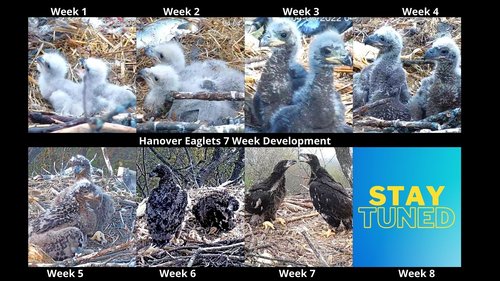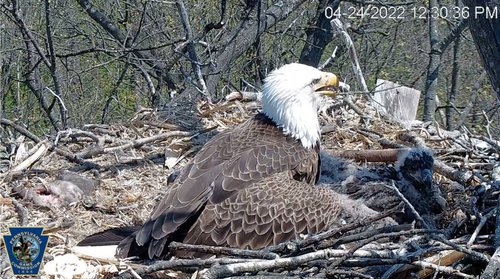Hanover Bald Eagle Blog # 16 - 2022
May 9, 2022
In partnership with Pennsylvania Game Commission and Comcast Business .
In just one week the Hanover eaglets have gone from the Yoda-look to sporting a nearly full coat of dark brown feathers. Lookin’ good! However, with more feathers comes more heat retention. As temperatures warm, the eaglets will need to find creative ways to cool off.

Fish, amphibians, reptiles, and insects are all ectotherms, meaning they gain and lose heat through the environment. For example, snakes often bask on warm rocks before dusk, soaking up some final moments of warmth, because they will be unable to generate their own source of heat once the sun goes down. Birds and mammals, on the other hand, are endotherms, meaning they produce their own body heat. Birds do not possess sweat glands, so they must use other tricks to cool off.
In addition to keeping their mouth open, birds flutter a patch of skin beneath their throat when they are hot. This skin is called their gular. The behavior is aptly called “gular fluttering,” and is believed to provide relief by dissipating heat by passing air over the eagle’s mouth..
In Blog 14 we discussed how, on cold days, eagles fluff their feathers to allow an insulating pocket of air to form between their skin and the air. On hot days, eagles de-fluff their feathers, which prevents that same pocket of air from forming at all, therefore reducing the insulating effect of their feathers. Eagles can also keep their unfeathered body parts such as the beak, talons, and legs exposed to allow for heat dissipation.
The Hanover eagles sometimes cool off simply by altering their posture. They stay out of direct sunlight when possible, and the parent on duty may use their wings to shade the youngsters. Luckily (or perhaps strategically), the Hanover nest receives some natural shade during the day.

Umbrella effect.
Like many birds, eagles take baths. This offers relief from hot temperatures, but also helps their feathers stay healthy and groomed. You can watch a video of eagles bathing near Vancouver B.C. here (trust me it’s worth it).
Most raptors have a core temperature of 40°C (104°F). Small raptors maintain a slightly higher temperature than large raptors since their metabolism is higher. For example, falcons have a higher resting metabolic rate than vultures or eagles. Additionally, the hearts and flight muscles of small raptors are (generally speaking) nearly twice the size as those of large raptors, in relation to overall body mass. What this means is that small raptors create and dissipate heat more rapidly than their larger cousins.
Imagine a 90 degree day with no air conditioning, no fan, and only the shade of a few branches to hunker beneath. Humans don’t handle such discomforts for very long, but the Hanover eagles have been creatively cooling and heating themselves for years, with nothing more than the ingenuity of their own instinct.
Sources
The Desert Adaptations of Birds and Mammals. (2022). Arizona-Sonora Desert Museum. Retrieved April 28, 2022, from https://www.desertmuseum.org/books/nhsd_adaptations_birds.php
Bald Eaglets. (2020). American Eagle Foundation. Retrieved April 28, 2022, from https://www.usask.ca/biology/bortolotti/pubs/wb96-4-524-542.pdf.
Bildstein, Keith. (2017). Raptors: The Curious Nature of Diurnal Birds of Prey. Cornell University Press.
SassePhoto. (2019, July 29). When Thousands of Eagles need a Bath. YouTube. https://www.youtube.com/watch?v=wL24zGasNLQ

Raptor Ecology Specialist Greenberg
RETURN TO HANOVER BALD EAGLE BLOGS
WATCH THE HANOVER BALD EAGLE LIVE CAMS
For over 20 years, HDOnTap has provided live streaming solutions to resorts, amusement parks, wildlife refuges and more. In addition to maintaining a network of over 400 live webcams, HDOnTap specializes in design and installation of remote, off-grid and otherwise challenging live streaming solutions. Contact press@hdontap.com for all media needs, including images and recordings.